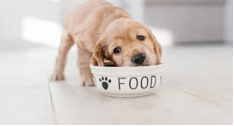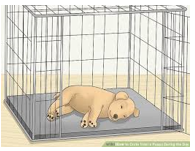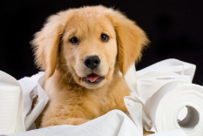Puppy Health Packet
Nutrition and Feeding
Nutrition, along with proper feeding techniques, is essential to your puppy's health. Each bag of food will have a recommended feeding chart, following those recommendations can help prevent obesity and allow your puppy to live its best life
- Avoid pet food with colored kibble, it is only there to look appealing to you, it does nothing for your puppy, and they could be allergic to the dye
- Feed a pet food that is specifically for a growing puppy
- Feed the highest quality of food your budget allows. Top-quality food contains fewer fillers which in return means a healthy puppy with fewer bowel movements
- Once you have selected a food, it is good to stick with it. Continuously changing their diet can cause digestive issues which bring on more unwanted puppy surprises (bowel movements)
- Allow your puppy 20-30 minutes to eat. If they don't finish, offer it to them at the next scheduled feeding. This will teach your puppy to eat at feeding time which will help with potty training (most puppies will need to potty 30-60 minutes after eating)
- Small and Medium-sized breeds can begin weaning off puppy food between 9 and 12 months
- Large Breeds should not begin food transition until 1 year of age
- Age 8-16 weeks: 3-4 meals a day (tiny breeds being 4)
- Age 3-6 months: 2-3 meals per day
- Age 6-12 months: 2 meals per day
- Human Foods to avoid: Chocolate, Grapes, Raisins, Milk/Dairy products, Macadamia Nuts, and Yeast Dough to name a few
- If your companion ingests anything toxic, please call ASPCA Animal Poison Control Center (888) 426-4435

Crate Training
Don't get frustrated; crate training may take days or weeks depending on your dog's temperament, age, and past experience. When crate training, it is important to keep two things in mind: Training should take place in a series of small steps, and the crate should always be associated with positive vibes. DO NOT USE YOUR CRATE AS PUNISHMENT
- Step 1 – Introducing Your Puppy to Their New Crate
- Place the crate in the house where the most family time is spent
- Place a blanket or toy in the crate
- Consider taking the door off the crate so the puppy can explore the crate at its own leisure (add the door back on after the introduction is complete)
- Some dog's curiosity will naturally lead it to explore the crate if not place a couple treats around the outside of the entrance and then a treat or two just inside the crate. This will lead the dog to enter the crate on their own
- Remember, do not get frustrated. Like humans, every puppy learns at a different pace. This may take minutes or days, but patience is most important when creating a feel-good environment for your puppy and their crate.
- Step 2 – Creating Confidence
- Begin feeding your puppy near its crate
- After a few feedings, begin setting the meals inside the crate. If the puppy is reluctant to enter the crate, set the food just inside the door. Over time begin moving the food towards the back of the crate. The goal is to get the puppy to eat at the back of the crate
- Once the puppy is eating their meals at the back of the cage, begin closing the door while they eat. At first, open the door as soon as the puppy is finished eating. Over time, start leaving the puppy in the crate for small amounts of time with the idea of working towards longer periods of time. If the puppy begins to whine, you may have increased the time at too rapid of a pace.
- If the puppy beings to whine, do not let them out right away, or they will associate whining with being released.
- Step 3 – Increasing Crate Time
- Once your puppy is eating meals without any anxiety or fears, you may begin increasing their time in the crate
- While you are home, begin crating your puppy for short periods of time with the idea of increasing the time of the next few days. Again, remember that every puppy learns at a different speed
- Now you can begin teaching your puppy a vocal command to enter the crate (use commands like "Crate," "Kennel," or "Kennel Up."
- Once you can leave the puppy unattended for about 30 minutes without any whining, you may now leave the house for short periods of time while leaving your puppy in their crate
- Step 4 – Leaving the House
- Do not physically force your puppy into their crate
- Put your puppy in the crate by using your command of choice. If needed, use a treat at the beginning.
- Alter the time of your "leaving routine" that you kennel your puppy. Some days you may kennel them 5 minutes prior to leaving while some days it may be closer to 15-20 minutes prior to leaving. Try to avoid kenneling your puppy more than 20 minutes prior to leaving the house.
- Do Not prolong your departure. Emotional and prolonged departures will only make things worse. Make your departure direct and to the point.
- Once you return home, your puppy will most likely become overly excited, do not reward this behavior. Keep your arrivals low-key to avoid increasing their anxiety over when you will return home.
- Continue to crate your puppy for small periods of time while you are home to avoid associating the crate with you leaving your puppy alone.

Potty Training
Potty training your puppy takes time, consistency, positive reinforcement, and patience. Typically, it will take 4-6 months and, in some cases, up to a year before your puppy is completely house trained. The recommended age to begin potty training is 12-16 weeks. The size of your puppy will also play a factor in potty training. Smaller breeds have a higher metabolism with a smaller bladder; therefore, they require more attention. Like most training, potty training will come with a setback, do not become discouraged. Remember, positive reinforcement is key
- Steps to Follow While Potty Training
- Take your puppy outside first thing in the morning and then every 45-60 minutes
- Take your puppy outside whenever they awake from a nap
- Keep your puppy on a strict feeding schedule and take the food away after 20-30 minutes. After mealtime is complete, take your puppy outside
- Take your puppy to the same area every time. His scent of the designated area will help prompt him to potty
- Stay with him while he is outside, at least until he is completely trained
- Once your puppy completes their business make sure to praise them and reward them with a treat
- Signs Your Puppy Needs Let Out
- Whining
- Circling
- Sniffing
- Barking
- Sitting near the door
- Scratching at the door
- Do's and Don'ts of Potty Training
- DO NOT PUNISH YOUR PUPPY FOR AN ACCIDENT. This will only cause your puppy to fear you
- If you catch your puppy in the act of an accident, clap loudly to help him recognize he is doing something wrong. Follow up by taking him outside to finish then reward with praise and/or a treat. DO NOT SCOLD HIM
- If you do not catch your puppy directly in the act of an accident, do not discipline or "rub their nose in it" A puppy does not have the intellectual capability to connect your anger with their mishap
- Do not use an ammonia-based cleaner to clean up the accident; ammonia may attract the puppy back to the scene for another accident






